My kichen feels like a factory at the moment. I am exhausted. Garden and foraged food have been preserved to get us through the winter. I am better at planning my preserving now. Notes have been taken of how much of each item we use each year and what tends to linger on the shelf, only to be used when desperate. An inventory has really helped. Knowing how much food to preserve stops waste, over crowded shelves, and saves me money and time going shopping.
It is tempting to preserve everything in sight. However, I only have so much room to store things, so many jars, and a set amount of sugar, salt, and vinegar that I can afford. I am therefore better at planning now. Records have been kept of what we have used in the past. It is easier to know how much we will need. I also take into account the various components of meals that we eat, how versatile the ingredient is, and how much nutrition we will gain.
Fresh herbs are used for half of the year, and so I dry 6 jars of mixed herbs for the rest of the year. Herbs like rosemary and sage are also dried separately. Mint, fennel, rosemary, and lemon balm are dried for teas. Herbs are an important part of our store cupboards as they add flavour and variety to our meals.

We buy large bags of spices from the world food aisle every 6 months for the same reason. They are a lot cheaper buying them this way. Spice and herb mixes that we use and make regularly like fajita and curry seasoning are taken into account when calculating how much we will need. Staples are also bought in bulk when they are on offer.
Fruit. I store lots of berries in the freezer as we eat compote every week. Probably over half of one of my freezers is full of them as I know I need a lot for the year. Some are foraged, and some are grown. A lot of apples are stored in my porch in newspapers and boxes. For the first time, I have made jars of Compote and waterbathed them this year. If they keep well, I will make a larger number next year to give me more freezer room.
Fruit is also dehydrated to make fruit rolls, apple crisps, and powder. Cordials are frozen or have citric acid added to them.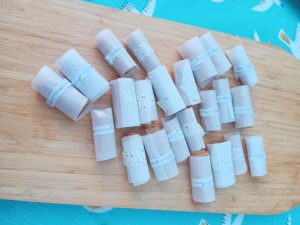
Jams. We don’t actually eat a lot of jam, but do use it in baking. Jams last a couple of years, and so I tend to make different flavours in different years. I also do smaller batches now. We use a jar of jam a month normally.
Vinegars. These are made with fruit or fruit peelings. I use 8 bottles of ACV a year and 2 bottles of blackberry balsamic glaze.
Tomatoes are turned into jars of passatta and tomato puree. I also freeze a few to throw in stews. Enough passatta is made to have 2 or 3 jars a month. Fresh tomatoes are used to make meals for some months of the year. Each year, I also buy 10 tins of organic tinned tomatoes when they are on offer for £1. They are better quality than the cheap tins and have more tomatoes in than the cheap tins. I don’t have enough storage room or jars to be self-sufficient in tomatoes, though this year I have grown enough. We are eating a lot of tomato based meals at the moment.
Vegetables – I have always frozen some of our vegetables, but have now started dehydrating things like grated carrot so that I can throw them in spaghetti bolognaise. Skins of onions and tomatoes are dehydrated and powdered to flavour soups, and stock is made with peelings.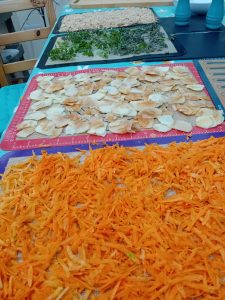
Beans and peas, I will freeze separately on a tray before bagging them. They don’t clump together that way. Sweet corn, I will cut kernals in half and then freeze whole. I only grow it every two years, and bags of sweet corn are cheap. I buy a couple a year.
Most other vegetables I don’t freeze as they take up too much space. I pickle 4 jars of red cabbage when it is 15p at Christmas and pickle beetroot and cucumber We also make chutney and piccalilli with vegetables. My first year of making chutney I made 15 jars. Now I know that we only use 4 or 5 a year. On the other hand Mr S goes through a jar picalilli a fortnight and so we make those when the cauliflower and courgettes are in season, but another batch when cauliflowers are reduced at Christmas.
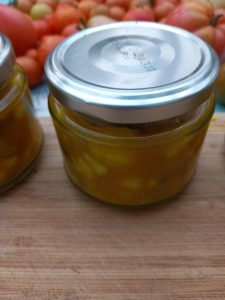
We do freeze some peppers and lots of chillies. The latter tend to get hotter in the freezer. Vegetables like potatoes, onions, squash, garlic and carrots are stored in boxes, or sand, and are also grown into the winter under glass, or in the green house. Recently I have started making more powders from foraged items to add to pasta, bread, and wraps for extra nutrition. Nettle seeds are also dried.
Sauces are another thing that we make with our vegetables. Sweet chilli sauce is our favourite but we have made hot sauce as well. We don’t make these in bulk but make 3 at a time. When we open the last bottle we make some more. We also make some fresh as Christmas presents in December.
Items are dehydrated to make tea blends, grains winnowed, we make various flavoured salts, essences to flavour baking, and pestos to freeze, For the first time this year we have made crystalised ginger to bake with as it is so expensive, but we love it. Syrups like rosehip have also been made for nutritious sweetening..
All of this preserving is such hard work but saves us money so that we only need a small food budget. Just as important is the fact that we know that the food is organic and full of nutrition. We couldn’t afford to buy this quality of food. Each year we learn new skills and knowledge and increase the variety of what we preserve, and hopefully knock something else off our shopping list. We are not self sufficient, but buy as little as we can get away with, and adapt to use what we have..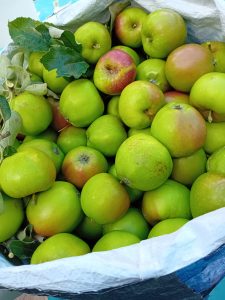
As we enter Autumn I am so thankful for the great bounty Mother Nature has provided this year. There are still things like acorns to be foraged and processed, but the hard work is coming to an end. It is difficult knowing how much to preserve and I don’t want waste, especially in these times of rising prices. However, we feel food secure this year. Finding different methods of preserving means that if the freezer fails for any reason, we will still eat. I just need to learn to like fermented food now. It would be a good edition to the pantry.
Have you managed to preserve a lot this year?
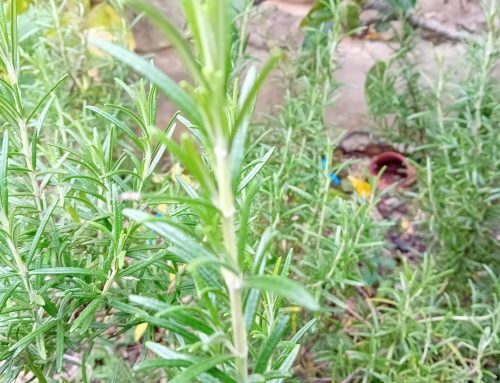
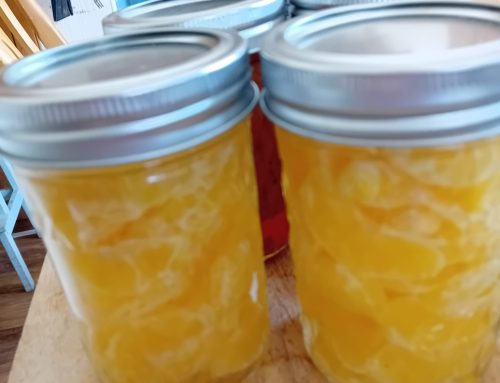
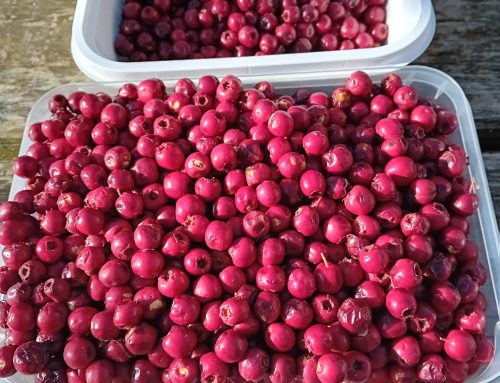

Definitely recommend fermenting food. Sauerkraut is easy and jazzes up plain rice or is brill to accompany a pastie or pie. And the ingredients are cheap! I’m going to do some kim chi soon, but only I eat that.
I’ll only do some green tomato chutney, for savoury preserves, but I’ve made two lots of strawberry jam and will do the Thrifty Leslie Sloe and Apple one later.
I have also made Apple Jelly which can be used with meat or on a scone. and hopefully I can also use it as a sweetener in bakes.
As you say, all these proper preserves will last years, so I’m happy to have plenty.
Passata will be very useful, that and half a small tub of cheap soft cheese makes a very cheap and quick pasta dinner.
I have about two ‘bags for life’ full of tomatoes in the freezer, as I can’t face processing them all at once. In fact I now have 3 freezers cos of the amount my allotment or foraging has yielded. I will water bath some as , like you I worry about power cuts. There’s also loads of fruit in there and I’ll compote some of that. Just the cost of cooking it has to be weighed up against freezer failure.
It does.it sounds like you are well sorted for winter as well
Goodness, so impressive. I have miso and soy and am intending to increase fermented foods. Would it help to know that eating them means the digestive system doesn’t have to work so hard, releasing energy for other things
Yes I know how good it is for me and have tried kimchi etc, but really struggle with the taste and so it doesn’t get eaten.
This was a great read! I would love to know more about your sauce making – especially sweet chili sauce.
I too can a lot of tomato puree, sauce and chopped tomatoes. I make salsa also. My family loves corn so we grow/source sweet corn and I cut off the cob, and freeze. I freeze fruit/betties and use in a multitude of ways. I grow herbs for cooking and make my own spice blends. Peppers are used usually but what’s not I freeze and will use later. I use to can green beans but we like them sautéed better now, I’ll freeze whole for use later. There is a lot I’ve done, but will be cutting back some in the coming years.
The recipe is on this website for the sweet chilli sauce.
Thank you, it was an enjoyable read. I’d be interested to know what your blend is for mixed herbs. I’ve tended to try and replicate the contents of an old commercial jar.
I second Heather’s comments on fermented foods. As well as sauerkraut and kimchi, I enjoy fermented red onions. I think red cabbage sauerkraut compares favourably with the pickled variety.
Made piccalilli today. I think my next project will be Pontack sauce. I could do with finding a few more elderberries. I think it’s great in winter casseroles etc.
Sounds good. I don’t have a special blend. It is always thyme, majoram, and rosemary, but some times I add oregano or basil.
You are brilliantly organised. It is very understandable, that you get exhausted, it is so much work, so worthwhile, but also so compressed timewise.
I do think, that you have made a misnomer in the tekst – you halve the corn cobs, right? Not the kernels.
Thanks. I will change it x
Impressive haul of potatoes there. I’ve grown them for the first time this year and they are lovely, so tasty. I grew them in four 30 litre buckets, but my harvest has been a bit small. I’ll try again next year and research how to increase my yield! Thanks for all the inspiration. Best wishes, Helen
This can happen if you plant too many potatoes to start with. I only put 2 in a builders bucket. It has also been dry this year which might have had an impact. Thanks.
I can only aspire to be like this, im just not that organised but I love reading about other peoples endeavours, thank you Toni for your blogs they are really interesting.
Aww thanks for your lovely comments. I wasn’t organised at first but get a little bit better every uear.
If you are not growing anything over the winter in that patch of soil, carrots can just be left where they are and harvested as you need them, unless you get very severe frost. Even then, a couple of layers of tarp or whatever would probably be sufficient protection. This might save you a lot of work and also loss of vitamin content dehydrating your carrots. It took me years to learn this…
That would be a good idea for some. My garden is on a steep hill and is treacherous in winter. I sow a bed of carrots in September which look after themselves over winter. I store the carrots sowed in spring in sand. I also leave my beds fallow and add nutrients so that the soil is good to grow from Spring. I sow under glass in my raised beds in March so that I have a long season of multiple crops. I like the idea of dried vegetables in my kitchen as I don’t need to get dressed up and go outside to get items. It also uses up less storage room. We often prepare food very early in the morning when it is still dark and so it works for us. You might be suprised to know that not many nutrients are lost when dehydrating carrots. Just some heat sensitive vitamin C, and our diet has lots of that from all the berries that we eat. Thanks for the idea, though.